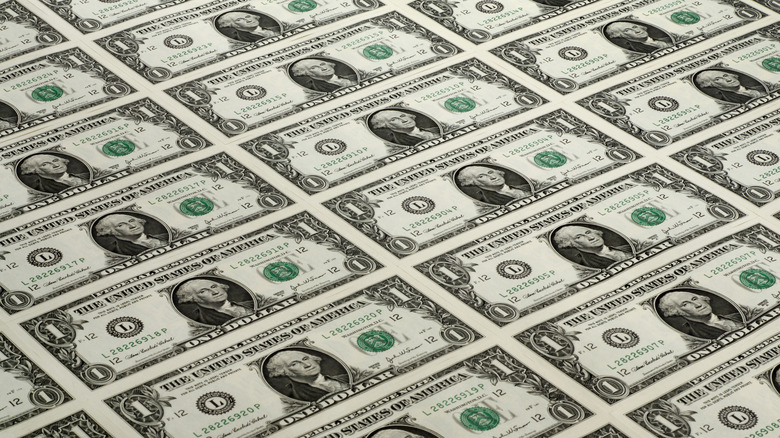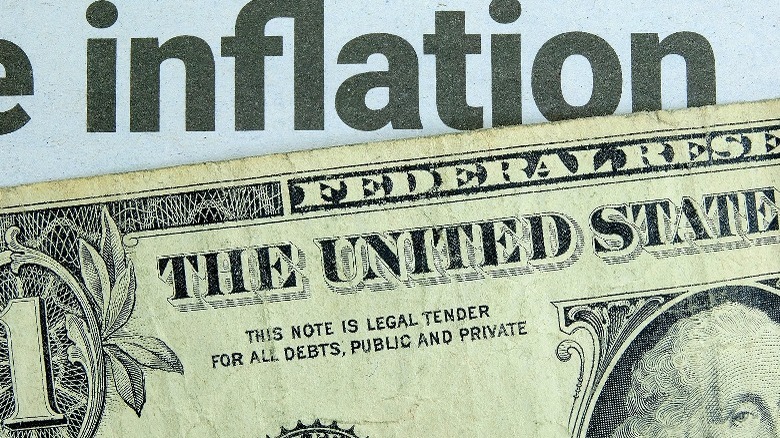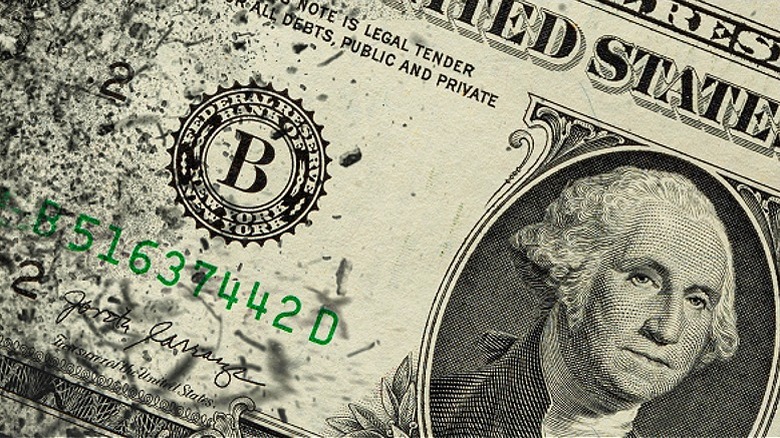How Much Does It Cost To Make A Dollar Bill?
When it comes to the $1 bill — a veritable staple in wallets, purses, and pockets everywhere — a plethora of fun facts abound. For example, the average life span of a $1 bill is 4.8 years. That may seem short, but it actually outlives several other bills like the $5 (3.8 years) and the $10 (3.6 years). Also, some folks assume that the $1 bill is the most prevalent in circulation because of its low value. However, the Federal Reserve says that at the end of 2022, approximately 14.3 billion singles were floating around, which is only good enough for second place. The most circulated bill by volume (units, not dollar volume) is the $100 bill, with approximately 18.5 billion in print. As you might imagine, the rarest bill is the $2, with only 1.5 billion units in circulation.
Because of its low value, counterfeiters don't often try to produce fake dollar bills. As such, the design has stayed the same for a longer period of time than larger Federal Reserve notes, which are periodically updated with anti-counterfeiting measures. In fact, the dollar has been unchanged since 1963. If you think that level of simplicity makes the bill cheap to produce, you'd be mostly correct. Though like nearly everything else in the United States, the cost to create $1 bills has risen with inflation in recent years.
Calculating the exact cost of $1 bills is complicated
Identifying the true cost of making dollar bills is trickier than you might expect. At first glance, it seems simple enough: The Federal Reserve's website pegs the latest production cost of the $1 bill at just 2.8 cents. Coincidentally, the $2 bill also costs the same 2.8 cents to make. So why do some sources indicate a much higher cost?
According to the Federal Reserve, 2.8 cents represents the variable cost, i.e., "the paper, ink, labor, and direct overhead costs to print each note." In comparison, the variable cost of each $100 bill is 8.6 cents because of the extra security measures it has, like a security ribbon that's embedded in the large denomination bills. For 2023, the budget for the variable cost of manufacturing all currency notes (every denomination) was $265.5 million.
Besides the $265.5 million, $587 million is also set aside for "fixed printing costs, which includes indirect manufacturing overhead and support, general and administrative, research and development, and prepress and engraving." It's the sum of those two costs that determine the total cost of making each bill. In the case of the $1 bill, the cost in 2022 was 7.5 cents.
It's illegal to deface dollar bills in any way
So there you have it. Each dollar bill cost 7.5 cents to make in 2022. Remarkably, that's up from 6.2 cents in 2021, which is quite a jump in cost year-over-over. Going back to 2017 when it only cost 5.4 cents to make each dollar, that represents about a 40% increase in just five years. Still, things could be worse — like coins, for example.
The U.S. Mint pays 2.72 cents each to produce pennies worth one cent. How crazy is that? Nickels aren't much better at a production cost of 10.41 cents against their face value of five cents. In theory, enterprising individuals could turn a profit by melting down pennies to extract their zinc and copper content, especially older pennies that contained a higher percentage of copper. However, there are a few barriers preventing this as your next side hustle.
To begin, it's against the law. In 2006 — presumably the first moment in time that the metal content of low denomination coins exceeded their face value — the U.S. Mint enacted a prohibition against melting coins for profit. Besides landing in jail, the labor and fuel required to melt the coins largely offset any potential profits — for now anyway.
Speaking of laws, it's also illegal to deface paper currency, which includes adding excessive writing, cutting holes, and gluing objects to bills, among other indiscretions. Those "Where's George" stamps that track the travel of $1 bills across the U.S. and even the world operate in the dollar bill's margins — literally. The text doesn't deface the bill to the point where it can no longer be used.


